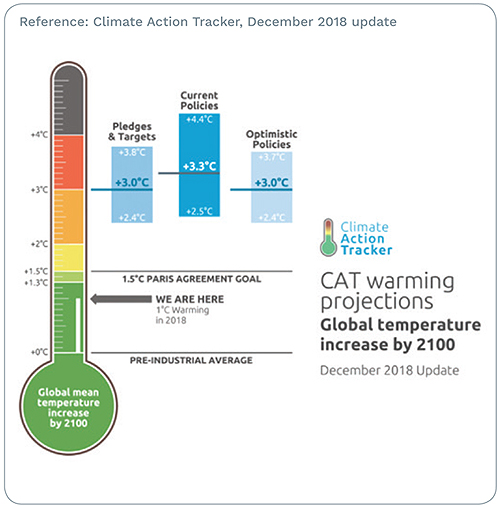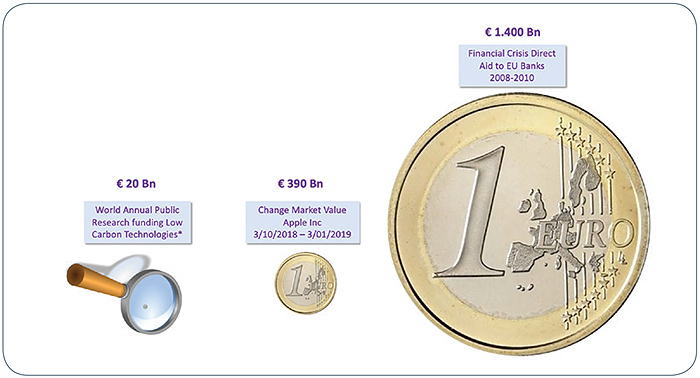 Just over three years ago, high representatives from 196 state parties adopted the Paris Agreement, in a pledge to keep the increase in global average temperature to well below 2°C above pre-industrial levels by the end of the century; with efforts to limit the increase to 1.5°C.
Just over three years ago, high representatives from 196 state parties adopted the Paris Agreement, in a pledge to keep the increase in global average temperature to well below 2°C above pre-industrial levels by the end of the century; with efforts to limit the increase to 1.5°C.
On this 12 December 2015, hopes were high that human kind could transcend its first ever existential challenge though uniting global efforts across nations.
On course to double our target for global warming...
Political gesticulations do not suffice anymore to hide the crude and stark climate reality; and citizens now protest daily their anguish over climate chaos in their millions.
Despite Paris Agreement promises, global emissions have continued growing relentlessly. Current policies are putting earth on a trajectory towards 3.3°C1 warming by end of century.
Climate Scientists across the world agree now on the "carbon budget", the total amount of CO2 the world could still emit for containing warming to 1.5°C or 2°C by end of the century.
Even in an overly optimistic scenario, were emissions would be kept to their current levels, the carbon budget limiting warming to 1.5°C with 67% probability would be blown in 2030. Just 10 years from now. Less than three times the period wasted since Paris Agreement was adopted.
Science has delivered technology faster than ever before
Today, more than any time before in human history, the pace of scientific development and scale of technological adoption have been mind-blowing. Many renewable technologies considered only 10 years ago as mere unrealistic engineer's fantasies, have become competitive mainstream energy technologies. For instance, cost of photovoltaics decreased by 85% over the last eight years, and by 50% just during the last three years, making it a highly competitive technology, as is already on-shore wind. Others are on a fast track to competitiveness.
And more. Beyond these known – now mainstream – technologies, scientists think the unthinkable. For instance, leading European research centers and universities are working on the promises of artificial Photosynthesis, allowing direct transformation of sunlight into chemical fuels and net climate neutral feedstock.2
But despite this unprecedented scientific evolution and technological development, we are collectively failing to curb emissions. The latest data suggests that we are on the verge of reaching tipping points in climate and ecosystems that might lead to an acceleration of planetary destabilization.

Since the "Age of the Enlightenment", man has consistently relied on scientific and technology development to overcome – or displace – the challenges of human society. But can technology now alone save human life on earth?
A new Age of Enlightenment: Science beyond technology
In the race to reduce emissions, technological development is a key enabler; but reaching climate neutrality is calling for actions reaching far beyond technology. It is about how human
activity can fundamentally restructure itself towards climate neutrality and how technology can be put at best use to support this transformation.
The Mission is to make society climate neutral, not to develop new technologies
The ultimate and only relevant goal for humanity is to avoid climate chaos by containing global warming.
Only a holistic, cross-sectoral and systemic approach can tackle such a challenge. It implies fundamentally rethinking the globality of human activities in all their relationship to energy in whatever of its forms. For instance, electrifying mobility only supports this mission, if carbon-free generated electricity is used to charge batteries that have been assembled with efficient and sustainable processes, and if circularity is implemented for core materials they use. And only if the resulting distributed electrical storage is designed as integral part of the electricity system can it avoid over dimensioning generators, transport and distribution networks or central storage. Furthermore, only if electricity, heat and gas networks are properly coupled, will we be able to use synergies, complementarities and switching capabilities between and across the various energy vectors. Only a systemic holistic and crosssectoral restructuring of human activity can achieve the challenge of climate neutrality.
No climate neutral society without social and lifestyle innovation
Today, economic and demographic growth are still strongly coupled to increasing carbon emissions, and the progressive alignment of the poorest countries to western standards reinforces this development. We witness the Jevons paradox: thanks to technological progress, we need less resources, but at the same time the rate of consumption rises, so that the gains are lost.
With the current limits to decoupling these parameters, achieving decarbonization targets will require, beyond technological breakthroughs, deep understanding of the drivers that enable us to steer the profound transformation of our core societal values.
Reaching climate neutrality will require a drastic change in the way citizens relate to energy production, conservation and consumption, a shift that needs to materialize in a much shorter time lapse than lifestyle, cultural and societal changes have historically occurred. Market mechanisms alone are highly unlikely to drive such a profound change, especially considering the well-known "rebound effect" through which household energy savings are usually mostly converted into other carbon-rich economic activities.
In that respect, social innovation will be essential to better understand how human kind can reinvent its society at a pace and to an extent that were never historically achieved. Climate urgency calls for new ways of thinking, designing, testing, implementing and deploying new societal models. Only trough allowing non-linear and cross-sectoral approaches fostering collaborative contribution of wide categories of historically disconnected stakeholders into a joint co-creation and co-designing effort, could human being invent new appealing society models and lifestyles that can be deployed and generalized at the required speed and scale.
Governments have a historical responsibility in redirecting funding
Progress beyond any expectations has been achieved in many low-carbon technologies. But to fully unleash the potential of existing and upcoming technologies, to redesign the technological, financial and societal system in which they need to interact, much more ambitious funding programs are needed, both at national and international levels. According to IEA, the global public low-carbon energy RD&D budget was about €20 billion in 2018.3
In contrast, in the aftermath of the 2008 financial crisis, more than €1,400 billion of direct aid from public money were authorized to 215 financial institutions4 representing about 70 times the world public annual spending in low carbon RD&D.

This suggests an absolute misjudgment of urgency, and the absence of political vision and ambition to combat the highest threat human kind has ever faced. Governments have now a historical responsibility to boldly reset the societal priorities by channeling public money and stimulating private investment with the scale and speed required by the immense challenge of transforming the technological, economic and societal foundations needed to decarbonize the society.
About EERA
The European Energy Research Alliance (EERA) is an association of European public research centers and universities active in low-carbon energy research.
EERA's mission is to Catalyse European energy research to achieve a carbon neutral society by 2050.
Bringing together more than 250 organizations from 30 countries, EERA coordinates research activities through 17 joint research programs. EERA is a key player and official partner in the EU's Strategic Energy Technology (SET) Plan.
In line with its Mission, EERA is committed to supporting Europe in achieving a successful energy transition in line with the EU’s climate 2050 goals and Paris commitments.
[1] Climate Action Tracker, December 2018 update
[2] "Sunrise" FET Flagship preparatory phase – an EERA partnership led consortium
[3] IEA Statistics – Energy technology RD&D budgets – May 2019
[4] "The cost of interventions in the financial sector since 2008 in the EU countries", Antonio Millaruelo and Ana del Río, Banco de Espana, Eurosistema, April 2017